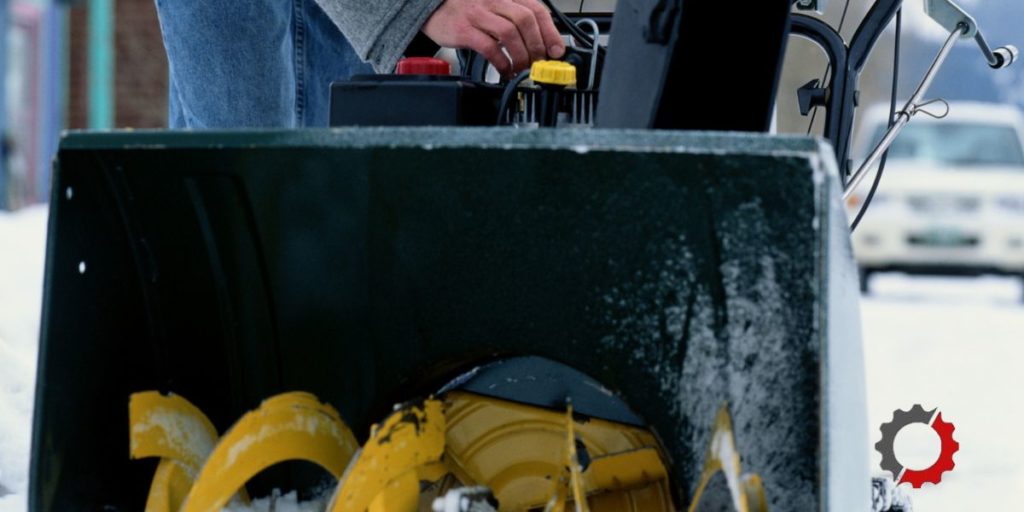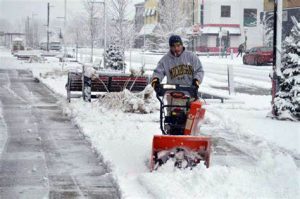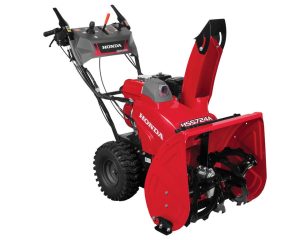10 Reasons Your Cub Cadet Snowblower Won’t Start: SOLVED!
Getting caught in the middle of a snowstorm with a snowblower that won’t start is frustrating! Without it, your snow removal task gets increasingly more difficult and takes a lot more time if you’re stuck using a snow shovel to clear a path through your sidewalk and driveway.
A Cub Cadet snowblower won’t start when there is a lack of air, fuel, or spark. This can be caused by a plugged fuel vent, stuck choke, clogged fuel lines, dirty carburetor, bad spark plug, faulty electric start, broken starter recoil, or old fuel.
Keep reading for additional items that will affect your Cub Cadet snowblower and prevent it from starting.
This is why your Cub Cadet snowblower won’t start:
- Incorrect Starting Procedure
- No Gas in the Fuel Tank
- Bad or Old Fuel
- Bad Fuel Cap
- Dirty or Damaged Spark Plug
- Fuel Line Blockage
- Engine Needs to Be Primed
- Dirty Carburetor
- Bad Electric Start
- Broken Recoil

This post may include affiliate links. Purchases made through these links may provide a commission for us, at no extra cost to you. As an Amazon Associate, we earn from qualifying purchases.
Follow all safety instructions provided in your equipment operator’s manual prior to diagnosing, repairing, or operating.Consult a professional if you don’t have the skills, or knowledge or are not in the condition to perform the repair safely.
Table of Contents
Reasons Your Cub Cadet Snowblower Won’t Start
1. Incorrect Starting and Operating Procedure on Your Cub Cadet Snowblower
You only use your snowblower a few months out of the year…sometimes a little longer depending on where you live. You may have simply forgotten the steps to start and operate your snowblower since you haven’t used it in so long.
Solution:
To start your Cub Cadet snowblower, make sure you are doing these 4 things before continuing to troubleshoot your starting problem:
- Set the fuel shut-off valve to the on or open position.
- Make sure the safety key is inserted into the switch. If your snowblower uses a toggle switch, make sure it is flipped to the on position.
- Set your snowblower to full choke.
- Set your throttle to ¾ to full throttle.
- Once started, adjust your choke to allow more air to allow your snowblower to continue to run.
Once your engine is warm, the choke must be placed in the off position or your snowblower will sputter and die.
2. No Gas Causes Your Cub Cadet Snowblower Not to Start
You may think running out of gas is such an obvious reason your Cub Cadet won’t start and it shouldn’t even be listed. Well, I have encountered many people over the years that simply skipped checking the fuel level.
I’m just mentioning this simple fact in case it was accidentally skipped out of frustration during your troubleshooting procedures.
Solution:
Determine whether your snowblower has a 2-cycle or 4-cycle engine so you fill it with the right fuel. Getting it wrong can cause significant engine problems.
- 4-Cycle Cub Cadet Engine: Fill the tank with fresh gasoline that has an octane level of 87 or higher. Choose a gas with an ethanol level no greater than 10%.
Most current snowblower models use a 4-cycle engine. You will have a fill port for oil and a separate fill port for fuel. Refer to your operator’s manual if you are unsure what type of engine is on your snowblower.
- 2-Cycle Cub Cadet Engine: Fill with an oil and gas mix following the recommended manufacturer ratio of oil to gas. An indication you are running a 2-cycle engine is a single fill port for both oil and fuel.
You may find the fuel-to-oil mix ratio listed on your fuel cap. If you are unsure what type of engine you have, refer to your owner’s manual.
Find more information on the correct fuel for your gas snowblower in “This is the Type of Gas Cub Cadet Snowblowers Use“.
3. Bad or Old Gas Causes Your Cub Cadet Snowblower Not to Start
Gas starts to break down as quickly as 30 days after you buy it. Because of this, it’s important to consume it within this timeframe to prevent old gas from affecting a snowblower negatively.
Most gasoline you find at the fuel station today includes an alternative fuel made of corn or another plant with a high-starch content. This product, ethanol, naturally attracts moisture to the fuel system.
While ethanol is okay to run in most vehicles, it isn’t good for the engine in your Cub Cadet snowblower.
Ethanol and the water it attracts can leave behind varnish and sticky deposits that can damage components and cause a blockage in the fuel system.
Stay away from gasoline that includes more than a 10% ethanol content. The lower the ethanol content the better.
Solution:
- Remove the old fuel using a fuel siphon pump. Add fresh fuel and a fuel additive to stabilize the fuel and clean the fuel system.
- Sea Foam is a product I use to help keep the fuel system clean. To learn more about the advantages of using Sea Foam in your engine, read my article “The Best Fuel Additive for Your Snowblower“.
4. Bad Fuel Cap Causes Your Cub Cadet Snowblower Not to Start
The fuel tank must be able to vent or it will form a vacuum preventing fuel from leaving the tank. This will starve your engine of gas and it will not run. You will find this vent built into the gas cap.
To determine whether a plugged fuel vent is the problem with your Cub Cadet snowblower not starting, remove the cap to allow air into the tank. If the snowblower starts, the fuel cap may be your problem.
You can further confirm the fuel cap is your problem by replacing the cap and allowing your snowblower to run for a while to see if it will sputter and quit.
Solution:
- Replace with a new cap if your cap does not vent.
5. Bad Spark Plug Causes Your Cub Cadet Snowblower Not to Start
Your snowblower requires spark in order to form a combustion to start and run. A fouled spark plug or one that is damaged can keep it from forming a spark.
In addition to a dirty spark plug, an improperly gapped spark plug or a spark plug wire that is not securely attached can cause your snowblower to fail to start.
Solution:
- Remove your spark plug and inspect it for signs of carbon buildup, a burnt electrode, or a cracked porcelain insulator.
- Replace with a new spark plug if the plug is too dirty to clean with a wire brush or if you find the plug is damaged.
- Make sure to gap them according to manufacturer’s specifications. It’s a good idea to check the gap even if you purchased the spark plug pre-gapped.
- Install the spark plug and make sure the spark plug wire (boot) is making a good connection.
6. Blockage in the Fuel Line Causes Your Cub Cadet Snowblower Not to Start
Old fuel and dirt can leave behind deposits that clog the fuel lines restricting fuel flow. Without sufficient fuel, your Cub Cadet snowblower will not start and run.
Solution:
- Check for blockages by first shutting off the fuel flow using the fuel shut-off valve or hose pinch pliers to crimp the fuel line.
- Identify a section of the line to check and remove the end of the line furthest from the fuel tank.
- Place the line into a container to collect fuel. Then turn on your fuel flow to check the flow coming out of the fuel line.
- If you find you’re not getting sufficient flow out of the fuel line because it is clogged, you are going to have to remove the clog.
- Stop your fuel flow and remove the section of the line from the snowblower so it is no longer attached to it.
- With the fuel line removed, spray carburetor cleaner into the tube to loosen the clog.
- Blow compressed air into the line to free the clog. Repeat spraying carb cleaner into the line and following it with air until the line no longer has a restriction.
- Replace with a new fuel line of the same diameter and length if you are unable to remove the clog or it has become dry and brittle.
7. Dirty Carburetor Causes Your Cub Cadet Snowblower Not to Start
A Cub Cadet snowblower uses a carburetor to regulate the amount of gas that gets mixed with air to form a combustion in the engine cylinder. This is also a part that is negatively affected by old fuel
Buildup from the varnish and deposits left behind by old gas can clog the fuel jet or cause components of the carburetor to become stuck.
When this happens, your snowblower isn’t able to function correctly to get the gas it requires to start.
Clean the carburetor by taking it apart and using carburetor cleaner.
Fix: Steps to Cleaning Your Cub Cadet Snowblower Carburetor
- Spray carb cleaner to minimize carbon buildup. Spray some carb cleaner in the air intake. Start the engine to see if it will run. If your snowblower fires up and still won’t stay running then we need to get inside the carburetor.
- Gather pliers, screwdrivers, sockets, and ratchets so you don’t destroy parts while taking the carburetor apart.
- Take a photo for reassembly. These days most people have a handy camera on their phones. It’s a very good idea to take a picture of the carburetor so you can refer to it if you don’t remember how to reassemble it after tearing it apart.
You will want to make sure you get a photo showing how the linkage and springs go back on the carburetor.
- Remove throttle cable and choke cable if your snowblower has one.
- Slowly remove the springs so you don’t stretch them out too much. You may have to twist the carb a bit to get the springs off. Also, watch the gasket at this point so you don’t tear it. This is the gasket located between the engine block and the carburetor.
- Remove the bottom screw from the float bowl. The float bowl is where gasoline is stored inside the carb. It should have gas in it so have a rag ready to catch the gas.
- Remove the bowl being careful to not damage the o-ring around it. Caution: Do not get any carb cleaner or any other chemical on the o-ring. It will stretch out and you won’t be able to reuse it.
- Inspect the stem for clogged holes. This stem hangs down from the center of the carburetor and has holes in it. If these holes get plugged from old fuel it will not draw fuel up to the jet.
If the holes are plugged, take a thick wire to clean them out. It’s easier to see what you’re doing if you use a flashlight. Once you get the holes clean you can rinse them with carb cleaner.
- Inspect the carburetor for hard crusty white buildup. This white buildup is fuel additives including ethanol. You need to try to get as much of the white power material out as you can. It’s nearly impossible to get it all out.
- Reassemble the carburetor now that the carb is clean. Put it back together in the reverse order you took it apart. Remember to refer to the photo you took of the carburetor when reassembling so all parts are reinstalled in the right places.
- Add fresh fuel that contains a fuel stabilizer before you start your snowblower. Pour the fuel into the tank and give it a chance to fill the bowl of the carburetor.
Start your engine. If you are starting with a pull cord, give the rope a yank. It may not start on the first pull, but it should start after several pulls and continue to run.
8. Bad Electric Starter Causes Your Cub Cadet Snowblower Not to Start
You push the button to engage the starter and your snowblower doesn’t start or turn over.
Make sure the cord is plugged in securely to the outlet in the wall and the snowblower. If it still doesn’t start, you could have a problem with the starter switch or motor.
One other thing to check is if your Cub Cadet requires a safety key in order to start. If it does, make sure the key is inserted into the switch.
Solution:
- You can use a multimeter to test the starter switch. Replace the switch if bad. Your Cub Cadet snowblower should also have a recoil starter to manually start it. Use this method until you are able to fix the electric start.
9. Engine Needs to Be Primed for Your Cub Cadet Snowblower to Start
For units without an electric start, priming your engine moves fuel from the fuel lines into the carburetor. I find it best to try to start the snowblower without priming it first.
Sometimes it doesn’t need to be primed and I don’t want to flood my snowblower by priming and adding too much fuel to the carburetor if it isn’t needed.
Solution:
- If your snowblower doesn’t start without priming, give the engine a little help by pressing the primer bulb a few times to get fuel into the carburetor.
- Do not over-prime your engine by placing too much fuel in the carburetor as you could end up flooding your engine.
10. Bad Recoil Causes Your Cub Cadet Snowblower Not to Start
Some Cub Cadet snowblowers use a recoil to start instead of an electric start. A bad pulley or spring in the recoil will prevent your snowblower from starting when you pull on the starter rope.
Solution:
- You can attempt to replace the spring and restring the recoil. If it does not work because other components in your recoil are damaged such as the clips or pulley, you are better off just replacing the recoil assembly.
Don’t Use Starter Fluid to Start Your Cub Cadet Snowblower: USE THIS!
Most people will immediately reach for the starter fluid when their equipment doesn’t start. I do not recommend this at all. In fact, I don’t like starter fluid so much because of the damage it can cause to the engine, I don’t allow it in the repair shop.
Starter fluid is a very dry chemical. Because it is so dry and doesn’t have any lubrication ingredient to it, the dry chemical can cause internal engine damage.
I recommend using carburetor cleaner to start your snowblower. I explain why carburetor cleaner is preferred along with how to use it in “Don’t Use Starter Fluid on a Snowblower: Use This Instead.”
Still Having Problems with Your Cub Cadet Snowblower?
When you own a snowblower long enough, you are going to run into several issues with it. Things like dying, not starting, or the auger not moving are just a few items you may encounter.
I have put together a guide to help you quickly reference things that can cause these problems. You can find it at “Common Cub Cadet Snowblower Problems and Solutions“.
If you encounter a problem that is bigger than you feel comfortable troubleshooting, contact your nearest Cub Cadet dealer for assistance.






